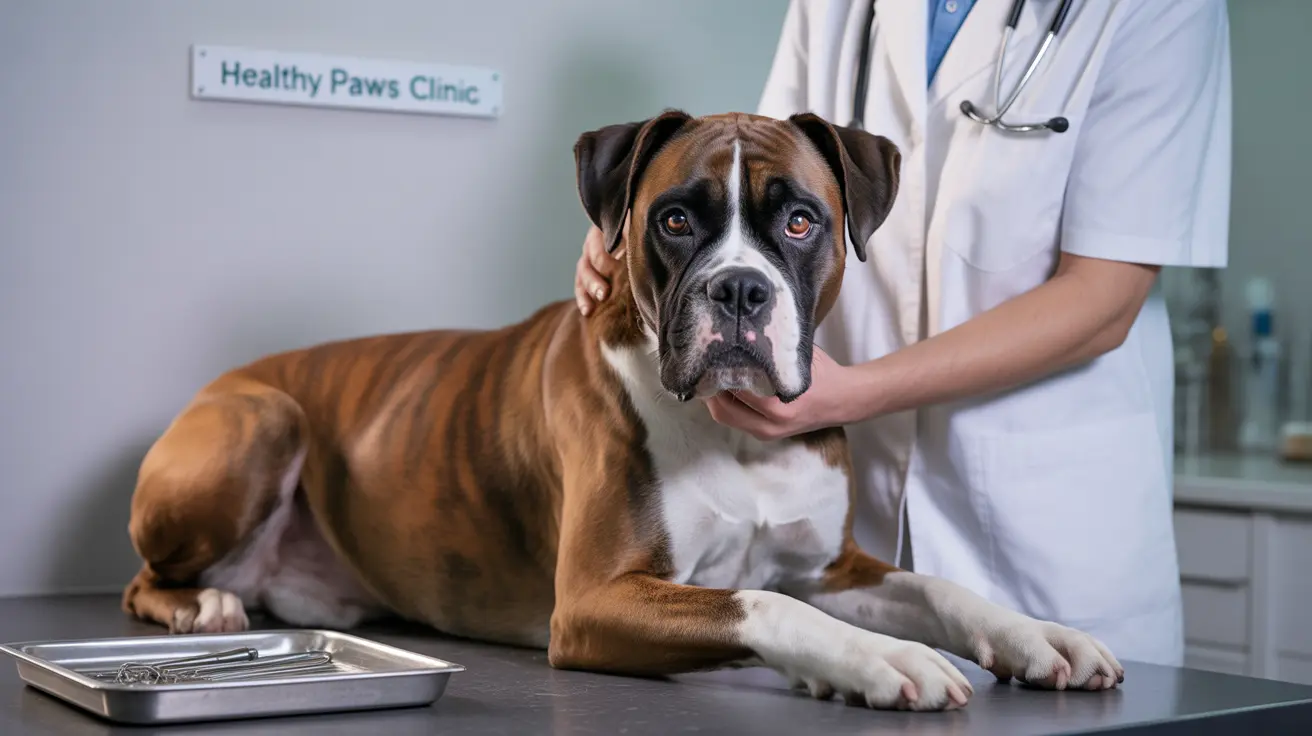When it comes to our canine companions' health, understanding dog skin growths is crucial for every pet owner. These growths, ranging from benign lumps to potentially dangerous tumors, are common occurrences that deserve careful attention and proper medical evaluation. Like humans, dogs can develop various skin masses throughout their lives, and distinguishing between harmless growths and more serious conditions is essential for ensuring optimal pet health. Early detection and proper veterinary diagnosis can make a significant difference in treatment outcomes and your dog's overall well-being.
This comprehensive guide will explore the different types of dog skin growths, their characteristics, and the appropriate steps for diagnosis and treatment. Whether you're dealing with a newly discovered lump or seeking preventive knowledge, this information will help you make informed decisions about your pet's health care.
Common Types of Benign Skin Tumors in Dogs
Lipomas: The Most Common Benign Growth
Lipomas are among the most frequently encountered benign skin tumors dogs develop, especially in older or overweight animals. These soft, movable masses consist of fatty tissue and typically appear on the trunk or limbs. While generally harmless, regular monitoring is essential to detect any concerning changes in size or texture. In rare cases where lipomas become very large or interfere with your dog's movement, surgical removal might be recommended by your veterinarian.
Histiocytomas and Their Characteristics
Young dogs frequently develop histiocytomas, which appear as raised, button-like growths on the skin. These benign tumors often resolve spontaneously within a few months, typically without the need for extensive treatment. However, because their appearance can mimic more serious conditions, it is always wise to have any new growth examined by a veterinarian. Histiocytomas are not generally painful, but monitoring for changes or signs of discomfort is important.
Identifying Malignant Skin Tumors
Mast Cell Tumors: A Common Concern
The mast cell tumor in dogs represents one of the most common malignant skin cancers. These growths can appear anywhere on the body and may change in size rapidly, sometimes swelling or shrinking from day to day. Because mast cell tumors can behave unpredictably and may spread to internal organs, early detection and prompt veterinary intervention are crucial for successful treatment. If a mast cell tumor is suspected, your vet may recommend immediate biopsy and staging to determine the best course of action.
Melanoma in Dogs: Signs and Symptoms
Canine melanomas typically appear as dark-pigmented masses and can be particularly aggressive when found in the mouth or on mucous membranes. Melanomas may also appear on the skin, toes, or nail beds. Early recognition and treatment of melanoma in dogs significantly improve the prognosis, as oral or digital melanomas tend to spread quickly. Look out for any new dark lumps, ulcerated masses, or growths that bleed, especially on the lips or inside the mouth.
Diagnostic Approaches and Treatment Options
Professional Veterinary Diagnosis
Accurate veterinary diagnosis for skin growths in dogs typically involves several steps to ensure the best treatment outcome. During a physical examination, the veterinarian will palpate the lump, check for pain, and evaluate its texture and location. Often, a fine needle aspiration or biopsy is recommended to collect a sample of cells, which are then analyzed under a microscope to identify the growth type. In some cases, advanced imaging such as ultrasound or X-rays may be necessary to determine the extent of the mass or detect any spread to internal organs. Laboratory analysis of tissue samples confirms whether the growth is benign or malignant, guiding treatment planning.
Treatment Strategies
Dog tumor treatment options vary depending on the type and severity of the growth. Some of the main approaches include:
- Surgical Removal: For concerning masses, especially those that are growing, changing, or causing discomfort, surgery is often the preferred treatment to completely remove the growth and prevent further complications.
- Regular Monitoring: Benign growths, such as lipomas, may only require ongoing observation to watch for changes in size, shape, or behavior.
- Chemotherapy or Radiation: In specific cases where tumors are malignant or have spread, your veterinarian might suggest additional therapies such as chemotherapy or radiation to manage the cancer.
- Safe Dog Lump Removal Procedures: When indicated, veterinarians use specialized techniques to ensure the lump is removed with minimal risk and discomfort to your pet.
Each treatment plan is tailored to the individual dog, taking into account age, health status, tumor type, and location.
Preventive Care and Monitoring
Regular Health Checks
Minimizing early detection dog cancer risks starts with vigilant and consistent home and veterinary monitoring. Key actions include:
- Monthly at-home skin examinations: Gently check your dog's entire body for lumps, bumps, or skin changes. Early detection increases the likelihood of effective treatment.
- Regular veterinary checkups: Annual or biannual appointments ensure that professionals can identify issues you might miss at home.
- Prompt investigation of new growths: Never ignore a new lump, especially if it grows quickly, bleeds, or causes your pet discomfort.
- Consistent pet health monitoring: Track any changes in your pet's health, appearance, or behavior, and share these details with your veterinarian.
When to Seek Veterinary Care
It is important to bring your dog to the veterinarian promptly if you notice any of the following signs:
- Rapid growth or changes in existing lumps
- Bleeding or ulcerated masses
- New dog skin nodules that were not previously present
- Changes in your pet's behavior, such as increased licking, scratching, or discomfort near the site of the growth
Seeking professional advice at the first sign of these issues can help catch serious problems early and lead to better outcomes.
Frequently Asked Questions
- What are common skin growths in dogs?
- Common types include lipomas, papillomas, mast cell tumors, and melanomas. Each of these can vary in appearance and behavior, so professional diagnosis is recommended for any new lump.
- How can I tell if a skin growth on my dog is dangerous?
- If a growth is growing rapidly, changes color, bleeds, or becomes ulcerated, you should seek immediate veterinary attention. Lumps that are firm, irregularly shaped, or fixed to underlying tissues are more likely to be concerning.
- Are most skin growths in dogs cancerous?
- Most skin lumps found on dogs are benign, like lipomas or cysts. However, some can be malignant, and only diagnostic tests can determine their true nature.
- What causes skin lumps in dogs?
- Lumps can form due to a variety of causes, including fatty deposits, infections, cysts, or cancerous changes in the tissues. Genetics, age, and environment may also play a role.
- How are skin growths in dogs diagnosed?
- Veterinarians use a combination of physical exams, needle aspirates, biopsies, and sometimes imaging to confirm the type of skin growth and plan appropriate treatment.
- What are treatment options for dog skin tumors?
- Treatment depends on the type and location of the tumor. It can include surgical removal, close monitoring, medication, and, for some cancers, chemotherapy or radiation therapy.
- Can dog skin growths be prevented?
- While prevention is difficult, regular vet checks and at-home skin monitoring improve the chances of early detection and effective intervention.
- Should I monitor every lump found on my dog?
- Yes. Any new or changing lump should be monitored and evaluated by a veterinarian, as early intervention is key when dealing with potential cancers.
- How often should my dog have skin checks?
- Monthly home checks and yearly veterinary exams are generally recommended, especially for older dogs or breeds prone to tumors.
- Is surgery always needed for dog lumps?
- Not always. Many benign lumps are monitored without surgery, but your veterinarian will recommend removal if there is a concern for malignancy, if the lump causes discomfort, or if it interferes with your dog's quality of life.
Maintaining vigilance over your dog's skin health and seeking prompt veterinary care when needed are essential aspects of responsible pet ownership. While not all growths pose serious health risks, professional evaluation ensures appropriate care and peace of mind for both you and your furry companion. Staying informed and proactive allows you to support your pet’s health and well-being throughout their life.






